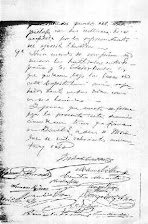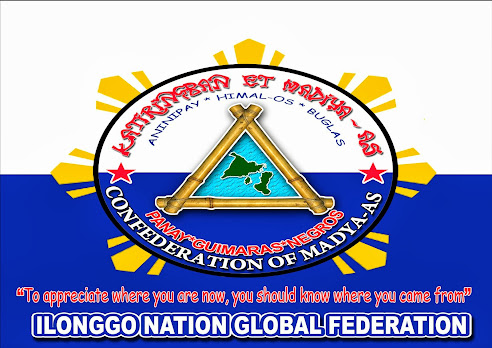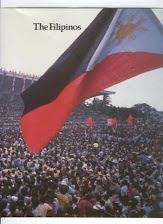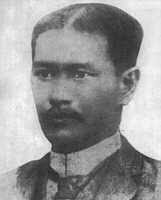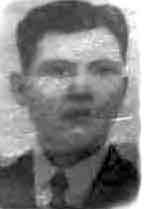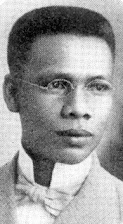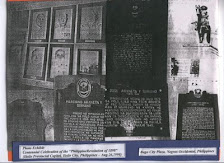Historical Facts obviously omitted or deliberately hidden in our School History Books
(Source: History Reborn"The Federal Republic of the Visayas" -by: dinggol a.divinagracia*June 12, 2007)
*That Spain had already formally surrendered to the Federal Republic of the Visayas even before Gen. Emilio Aguinaldo was proclaimed Philippine President in Malolos, Bulacan on January 23, 1899. That our Independent Visayan Republic, had never been under the authority and jurisdiction of Aguinaldo's "Katagalogan" Republic in Luzon.
excerpted: "...A paper written by Jose Manuel Velmonte, a research associate at the UP Third World Studies Center, found that the Visayan revolutionary elites not only had sophisticated political ideas but also resented attempts by Malolos to assert its authority. A Tagalog military expedition sent by Malolos to Panay to assert its presence was met with hostility. The Luzon force led by Generals Ananias Diocno and Leandro Fullon was regarded by the Visayan revolutionaries, led by the Visayan supremo, Gen. Martin Delgado, as an ''invasion'' force ..." (Source: Inquirer-1999- 06-13 "View of revolt in provinces spurs revision" By: Amando Doronila)
According to Dr. Luis C.Dery, an eminent Filipino Scholar: "Expounding the extent of Aguinaldo's Philippine Army; the Bangsamoro nation's Mindanao, Sulu, and the rest of its islands never fell under Aguinaldo's politico-military control and sovereignty. In fact as late as August 1898 much of northern Luzon, southern Luzon, the Visayas, and Mindanao remained outside of the control of Aguinaldo's Republic. Thus, several military expeditions were sent to these places to bring' them to recognize the First Philippine Republic."
*That the 1898 Treaty of Paris preliminaries, should not have included territories of the sovereign "Visayan Nation"; the confederation of both the Central and Western Visayas Cantonal Governments by virtue of Spain's formal surrender prior to this U.S. and Spain treaty of peace (Paris) and the $20-million buy-out. Spain had no more legal rights to sell. This diplomatic "Faux pas" that was supposed to be officially consummated and became legal and internationally binding only on APRIL 11, 1899 should, or rather must be rectified.
~~~~~~~~~~~~~~~~~~~~~~~~~~~~~~~
*June 12, 1898 -Gen. Emilio Aguinaldo proclaimed Philippine Independence from Spain in Kawit, Cavite --but never won the war against Spain, as explained in the infamous betrayal --the "Mock Battle of Manila of August 13, 1898".
*Nov. 6 & Dec. 23, 1898 -Spain formally surrendered to both; the Negros Republic that merged (Dec. 2, 1898) with the Federal Republic of the Visayas based in Iloilo (respectively)excerpted: "...These two nations, from a purely legal point of view, are COMPLETELY LEGITIMATE UNTIL TODAY. This could imply that the Manila-based Tagalista-oriented Unitarian central government of the Philippines in the Visayas and Mindanao is an Occupational Government, that ultimately originated from an invalid Treaty of Paris...."
Dr. Jose P. Dacudao; National President -Save Our Languages thru Federalism Foundation (SOLFED), Inc.
*July 4, 1946 -The United States of America granted Philippine Independence on a silver platter with strings attached. "True Independence could never be just self-proclaimed nor bestowed upon, it has to be won and duly achieved with dignity" -- DinggolAranetaDivinagracia (Founder: Ilonggo Nation Movement (INM) Global Network ..Dec. 25, 2005)
Dinggol is an Ilonggo Historian of modern times. He is a lover of nature and reform activist by profession; a genealogist by avocation, and an avid advocate of the Cooperative Movement and "Parliamentary" Federalism. He is, likewise, a duly registered Researcher at the U.S. Library of Congress in the nations capital --Washington D.C.
"It is rather speculative as it is without basis of history if we mean of "history" is that which had been written for us by the "tutas" or lackeys of our colonial and imperial masters.." -- Benjie Evicner Estuche (INM Co-Founder)
"Federalism is not the best way, it is the only way".. ~~~~~~~~~~~~~~~~~oo0oo~~~~~~~~~~~~~~
Join the Last Laugh with us! *When Christopher Columbus said that the world is round, people asked -What? and then they laughed.
*When the Wright brothers said they'll fly and soar the skies, people asked -How? and then they laughed.
*When Jules Verne wrote someday man could travel below the seven seas and shall walk on the moon, people asked - When? and then they laughed.
*When John the Baptist prophesied the coming of the Lord, the Messiah, people asked -Who? and then they laughed.
*When the Ilonggo Nation Movement (INM) Global Network announced its mission and vision, people did not even bother to ask, What? How? When? or Who? --They just laughed and laughed. *People are still laughing, ...but the laughter is fading!
Ang inyo alagad sa guihapon -DinggolAranetaDivinagracia~~
Claim your birth right,
VISIT AND JOIN US! AT: "GLIMPSES OF ILONGGO HISTORY"
https://www.facebook.com/groups/2470058109983695
~~~~~~~~~~~~~~~oo0oo~~~~~~~~~~~~~~~~~~


